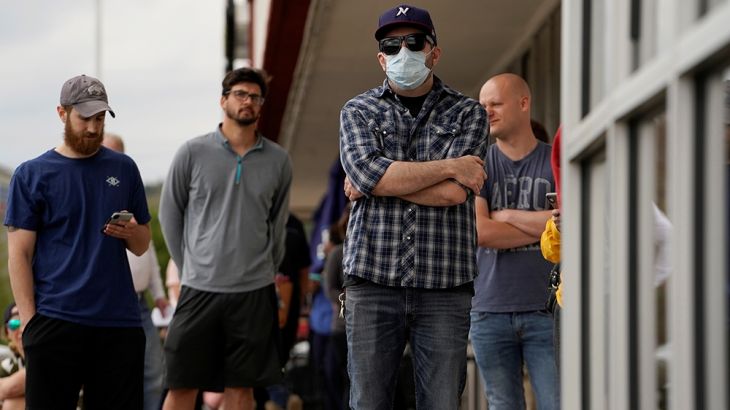US economy loses a record 20.5 million jobs in April
Job losses from coronavirus lockdowns send US unemployment rate skyrocketing to highest level since Great Depression.

We have never seen anything like this before.
The depth and breadth of the damage inflicted on the United States economy by coronavirus lockdown measures came into sharp, painful focus on Friday with government figures showing a record 20.5 million Americans lost their jobs in April.
Keep reading
list of 3 itemsCoronavirus recession will hit women harder, experts warn
For millennials, coronavirus economic blow awakens bad memories
Data from the US Bureau of Labor Statistics (BLS) also showed the unemployment rate skyrocketed to 14.7 percent last month – the highest since the Great Depression.
Behind all of these numbers are real people whose livelihoods have been brutally and tragically disrupted by the pandemic.
The data further confirms the overwhelming consensus that the US economy is in the throes of a sharp recession. But in a sobering reality check, the headline numbers likely understate the true scale of the carnage.
“Although the unemployment rate only climbed to 14.7 percent, slightly below expectations, that was principally because the BLS is still having problems with misclassifying absent workers who should have been recorded as on temporary layoff,” Capital Economics chief US economist Paul Ashworth wrote in a note to clients. “Without that distortion, the unemployment rate would have been close to 20 percent last month.”
Though historic, the data came as no surprise. Some 33.5 million Americans filed for unemployment benefits in the seven weeks ending May 2, offering a preview of the monthly damage on tap.
But the April numbers do provide more details about which workers and which sectors of the economy were hardest hit by stay-at-home orders.
Broken out by race and gender, the unemployment rate hit 13 percent for adult men and 15.5 percent for adult women; 14.2 percent for whites, 16.7 percent for Blacks, 14.5 percent for Asians and 18.9 percent for Hispanics.
All of these groups with the exception of Black people posted record high unemployment rates.
Every major sector of the economy haemorrhaged jobs last month, but losses were particularly acute in leisure and hospitality where employment plummeted by 7.7 million, or 47 percent. Nearly three-quarters of that carnage – some 5.5 million job losses – were borne by food services and drinking places.
Education and health services lost 2.5 million jobs in April, while healthcare shed 1.4 million, led by losses in dentists’ offices.
Employment in professional and businesses services, and retail trade each fell by 2.1 million.
Some 1.3 million manufacturing workers lost their jobs in April, with nearly two-thirds of that total coming from personal and laundry services.
Job losses in construction were just shy of one million last month.
The average work week for all employees ticked up slightly in April to 34.2 hours, but Bureau of Labor Statistics commissioner William W Beach urged caution when interpreting that data, noting in a statement that “the majority of the increase in average weekly hours reflects the disproportionate number of workers with shorter work weeks who went off payrolls.”
Beach also urged caution when interpreting the $1.34 rise in average hourly earnings because it reflects the disproportionate loss of low-wage jobs.
When will the labour market recover?
The big question now is when the US jobs market will return to its pre-coronavirus strength. With so many unknowns surrounding the trajectory of the pandemic, forecasts are riddled with uncertainty. But economists are doing their best with the data they have to hand.
A lot is riding on how long it takes consumers to regain their confidence and start spending again on goods and services, because consumer spending accounts for roughly two-thirds of US economic growth.
Gregory Daco, chief US economist at Oxford Economics highlighted this point in a note to clients on Friday,
“We anticipate that the severe income loss, elevated precautionary savings and lingering virus fear will curtail consumer demand well past the lockdowns,” he said, adding that “while we expect some jobs will be recovered over the coming months, we anticipate an unemployment rate well above 10 percentby year-end.”
During the Great Recession and its aftermath, the number of job seekers overwhelmed the number of open positions for years. This extreme “slack” in the labour force depressed average wages and analysts say that could well happen again.
In a note to clients on Monday, Goldman Sachs chief economist Jan Hatzius said: “Even under a reasonably optimistic growth forecast, it will take several years to put people back to work and fill empty offices and storefronts,” he wrote, adding “while we expect some jobs will be recovered over the coming months, we anticipate an unemployment rate well above 10 percent by year-end.”